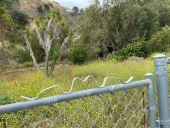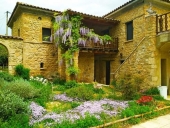
 2
2








 2
2




Paul Crellin wrote:Hi,
1. As an initial high level question… am I mad to be considering buying this plot for mixed agricultural / forestry / pastoral use? What if considering as a lifestyle permaculture farm where profitability is less important?
It's almost certainly not going to make you much money.
2. Do you think it’d be feasible to have a kitchen garden/small market garden on this ~20% (11deg / 1:5) gradient? Would it be necessary to terrace / flatten it in some way if I wanted to grow annuals? I’m imagine I’d put no-dig beds on contour as I expect that’d be easier to work.
Yes that slope is not a deal breaker, there would be no need to terrace.
3. Do you think it’d be possible to keep small numbers of cows on this slope in a self-sufficient way? I should note that while the slope varies there are no completely flat areas, would this be an issue for the welfare of the livestock? I envisage ideally having 2 cows at a time + potential calves (I don’t like the idea of keeping singles of herding animals). Ideally I’d want to have minimum infrastructure - given our winters are mild I’d hope to be able to keep them outside for as much of the year as possible. I suspect this would probably pushing the land a bit far in terms of its ability to handle the animals when wet and in terms of the amount of pasture/forage it could produce.
Ask local farmers how much land per cow is needed. Down in the South of the country they considered 2 acres enough for 1 cow all year. BUT it's better weather down there and they were not talking about hill land. You'll probably have the have the cows in between November/December until March. It's not the cold that's an issue it's the wet, cows on wet land will quickly ruin the entire thing. If it's very thin stony soil you might be able to have them out longer.
4. I appreciate that there are huge numbers of variables to take in to account here but I’ll pose the question anyway in the hope that someone may be able to offer some insight if not a direct answer… If the answer to the previous question was yes, approximately how many acres would you expect I’d need to give over to 2 cows with calves if they are to be primarily pasture fed (grasses/legumes/etc) given it's a north east facing slope?
Max 8 probably closer to 6 (assuming you are not running Holsteins or something silly)
5. Other animals that I’d potentially look to keep in small numbers are listed below, do you think any of them would have issues with living on this gradient? I understand there can be issues with fencing on steep gradients for some of these animals - if you can think of any other potential issues that may impact keeping please could you advise?
* Chickens
* Pigs
* Other poultry (ducks, turkeys, etc)
* Goats
* Sheep
* Alpacca / Llama
No animal is going to have a problem on that slope.Putting animals on slopes is what we do!
6. I like the idea of putting/keeping at least 30% of the site I eventually purchase back to nature with mixed broadleaf woodland and wildflower meadows or whatever suits it really. I don’t imagine there would be any issues doing this on a slope like this but I’m happy to take advice if anyone would suggest otherwise.
Check the wind levels on that hill, those bushes at the top look rather stunted, you might find that sheep grazed downland is what you naturally have there.
7. I can envisage, in time, trying to put some form of water storage, such as a pond, in higher up on my part of the slope. Do you think that would be feasible given how steep the land is? I should note I have no specific plans in mind at this point but given the droughts facing Britain in future I think early planning for some form of water storage would be sensible.
The land really isn't that steep, planning permission and geology are going to be more of an problem.
8. I’ve not yet done any soil assessments etc and wouldn’t really know what to look for on a site like this. In the past all I’ve done are PH tests and thumb tests for soil type. Would you recommend anything else? Is it worth performing full agricultural soil tests? I expect I should be able to plant to the existing soil types and build soil and solve any deficiencies as and when I need to - is that a bit naive for such a large scale?
It's much easier to start with something decent. one issue up there might be soil depth, I would certainly go look at that.






 1
1




Jd
 4
4




Sometimes the answer is nothing





Sometimes the answer is nothing





Paul Crellin wrote:
The size of the land is actually why I was looking in to / asking about animals - before considering this site I didn't intend on keeping anything more than some kind of poultry. But given the acreage I think I'd need to do something to prevent it from turning to scrub and animals would be one of the options I'd consider.


 1
1




J Davis wrote:I found sepp holzers permaculture book to have a lot of good info on workimg with steep slopes.
Spoiler, narrow terraces , silvopasture, animals, ponds. All do-able. But great care and thought is required to study the site, slowly transform the land and to avoid erosion causing mistakes.




wayne fajkus wrote:What are the cow plans? Is it 2 femalea, no bull? What is the plan for their offspring? Sell them, raise them and harvest them? These lead to lots of other questions.
My place has 2 breeders and one bull. But i raise them to harvest time. This means i always have 5 (the 3 plus 2 offspring). And for half the year i have 7 (2 new offspring added but original 2 not ready for harvest yet)
See how things get out of hand pretty quickly? Sometimes i think "why am i doing this?:. If i used Salitans approach of buying cows at 500 pounds and not breeding them, it would be so much easier. I can raise them to slaughter, then take half a year off and let the grass grow. I have criticized this method cause its not "self sufficient ". I want to go full circle. From birth to plate.
wayne fajkus wrote:
I would maybe advocate the Salitan thing on the first go around. It gives you an exit strategy if land cannot support them. Puts a lot less pressure on the grass than getting to 7 cows. I'm just too stubborn of a Homesteading Texan to do it myself




Skandi Rogers wrote:
HA I know that feeling I've got 3.2 hectares at the moment (will be dropping 1 as it's at a different property) and we're going to have to get something to graze we're looking at 2 yearling cows probably highlands/belted Galloway or crosses there of as those are the small cows we can get, however there are a lot of Holstein boys being brought up round here so it may be a pair of them. of course at 1 acre of land for them we don't have enough for year round grazing, I would get them in April when the grass starts and cull/sell in November when the grass is gone and my potatoes are all used up! I thought about sheep, but the husband doesn't like to eat wool (his words not mine) and I don't really want any animals over winter. Also his dad was a dairy farmer and still is the local AI man, so they have plenty of bovine experience.
 1
1




"You must be the change you want to see in the world." "First they ignore you, then they laugh at you, then they fight you, then you win." --Mahatma Gandhi
"Preach the Gospel always, and if necessary, use words." --Francis of Assisi.
"Family farms work when the whole family works the farm." -- Adam Klaus




R Scott wrote:As for the garden, raised bed planter boxes can be built to terrace ridiculous slopes, you shouldn't have a problem. The uphill side may be 6 inches of soil and the bottom side three feet deep, but that makes them real easy to work. Just make sure to secure them so the don't slide down the hill in the rainy season. Last time I helped build such things, we filled the bottom with rock and sub soil so we didn't need as much topsoil.




Long balcony garden in the green Basque Country
 1
1




This is all just my opinion based on a flawed memory





Dave de Basque wrote:For what it's worth, I think you should go for it! (But then again, I know, I don't have to deal with the consequences...)
Dave de Basque wrote:ask your neighbours to graze their cows on your land, whichever bit you don't really feel enthusiastic about managing




Ben Zumeta wrote:it was mentioned that any land over 15% grade was kept as permanent forest, largely conifers. This was because conifers provide their full erosion control year round, whereas deciduous trees are far less effective in winter. Just my 2 cents.










Long balcony garden in the green Basque Country




This is all just my opinion based on a flawed memory

 1
1




Earthworks are the skeleton; the plants and animals flesh out the design.



 1
1




Ben Zumeta wrote:I have never raised large livestock myself. However, in research I've done on their management to prevent erosion and desertification, grazing is restricted to land with less than 5% slope. In addition to the increased need for vegetative cover on ground of steeper slopes, it also becomes very difficult to fence steep and irregular terrain. So the way you would avoid overgrazing by rotating pastures would seem to be quite difficult to do on such steep ground. In the Loess Plateau restoration videos, it was mentioned that any land over 15% grade was kept as permanent forest, largely conifers. This was because conifers provide their full erosion control year round, whereas deciduous trees are far less effective in winter. Just my 2 cents.
"If we do not find anything very pleasant, at least we shall find something new"
 1
1




Joy and abundance, Cory "Cimarron" Layne - Building a Permaculture community on 30 acres in SW Virginia Appalachian Foothills. Still looking for liberty-loving, resilient people ready for a challenge. PM me with your email address for more info.

|
look! it's a bird! it's a plane! It's .... a teeny tiny ad
The new permaculture playing cards kickstarter is now live!
https://www.kickstarter.com/projects/paulwheaton/garden-cards
|






